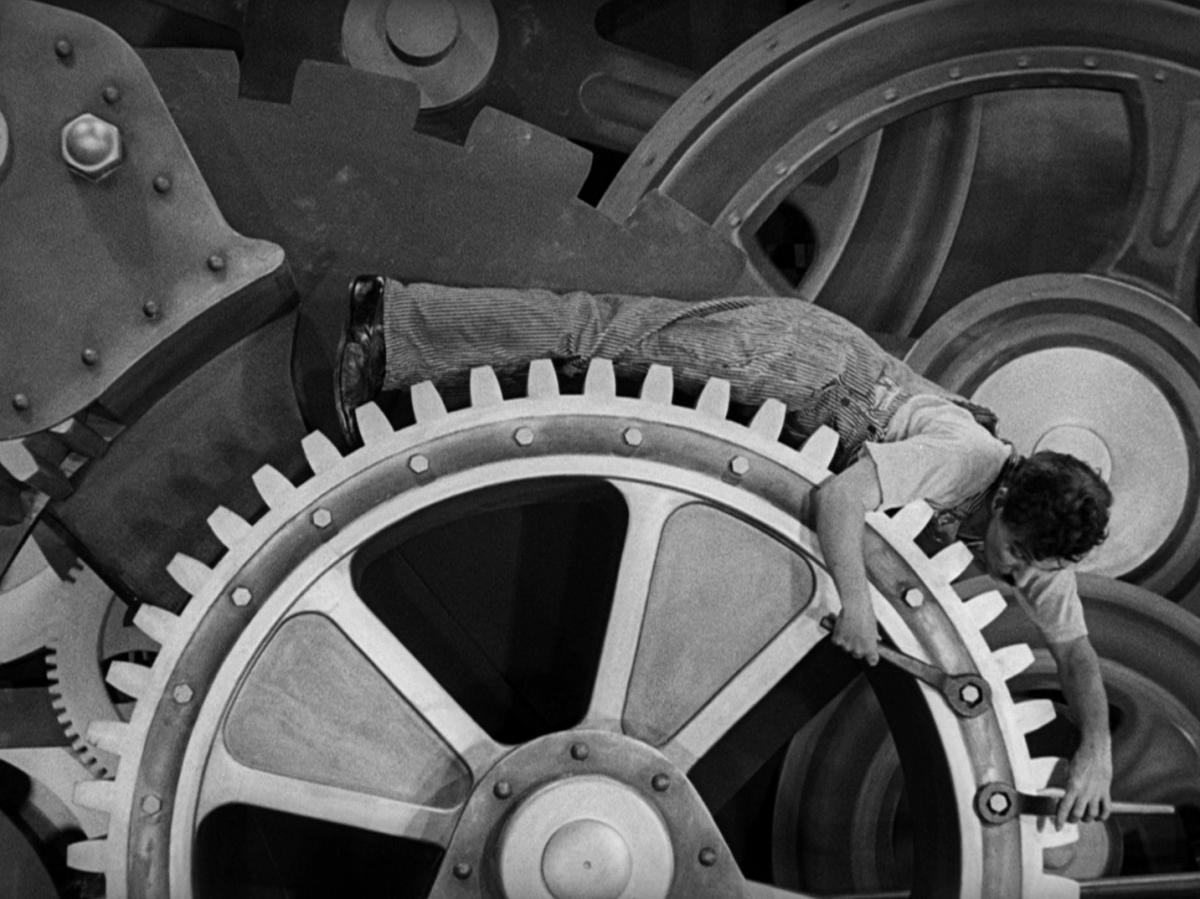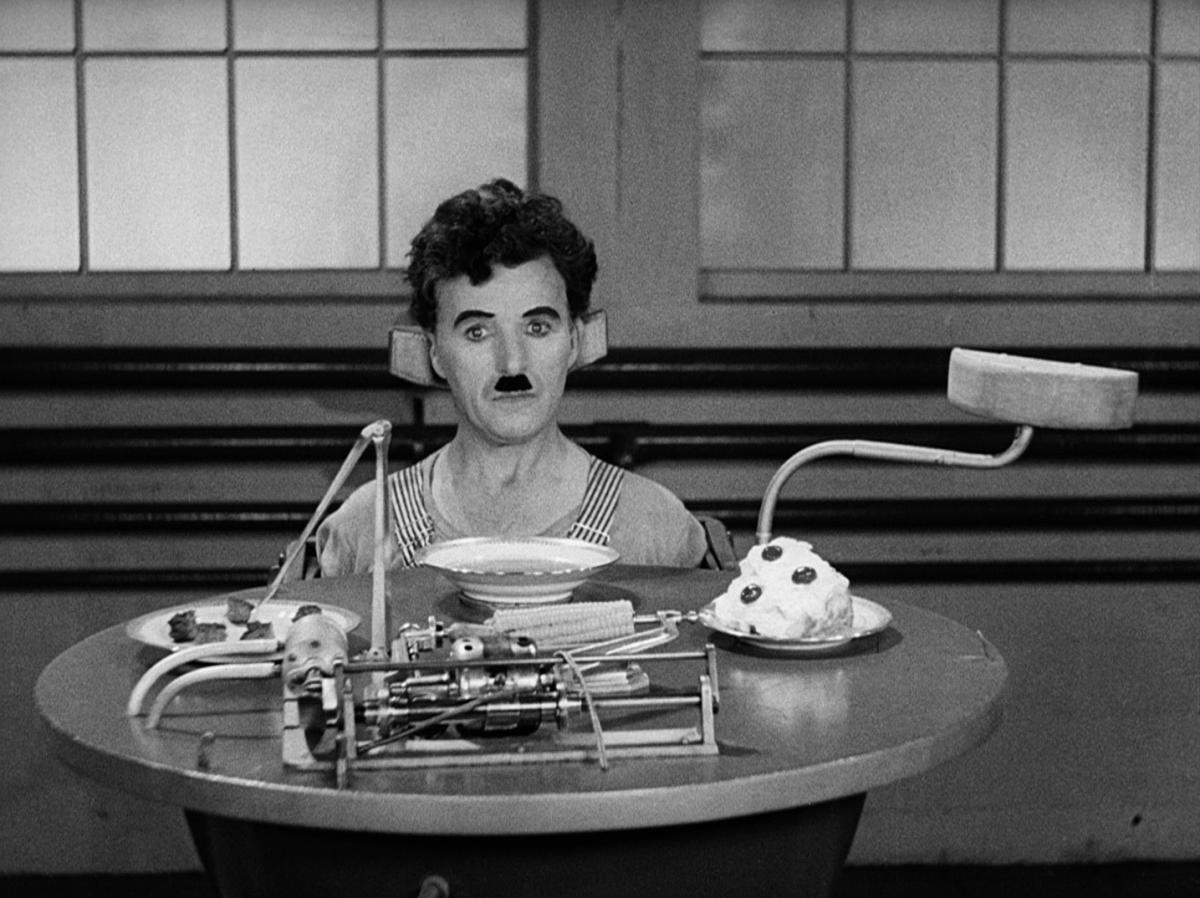Modern Times

There I was again. Despite the warning of some clairvoyant friends, waiting for a Chaplin. Internally preparing myself for a cultural event, for a revelation and discovery. In spite of myself, I felt like Bazin when he first saw Limelight. One of the things he wrote about it afterwards was the following: “But I have no doubt that this historic screening was something other than the avant-première of Limelight. The qualification of the spectators on one hand, but above all the presence of Chaplin turned it into a complex event, of which the film was only one component. We were in the presence of Chaplin, the spectacle of his death throes. And we wept with all the more emotion because we knew he was there and alive.”
Bazin is describing an emotional complex that, I believe, is peculiar to all Chaplins and all screenings of Chaplin. The feeling of absence and presence is what defines Chaplin’s oeuvre. Over and over again, he managed to “be there” and “not be there”.
Take, for instance, Modern Times. A film from 1936, with barely any dialogue, built entirely according to the rules of silent film. Even then, he was out of date, he was history, and deliberately so.
Or take his vagabond character. From his first little films, he fixates on a (European) nineteenth-century figure. He belongs in cabaret and circus. And hasn’t circus, since the development of the entertainment industry, fundamentally and always been “a farewell to circus”? Or take the melodramatic situations and social relationships: the unemployed widower with three daughters in Modern Times. Popular theatre (such as D’Ennery and Cormon’s The Two Orphans from 1875, touring Dutch theatres at this very moment) and the popular novel of last century were imbued with this kind of a sentimental approach to human relationships.
Chaplin is therefore very un-American (which is easily understood as universal). His view of society, the motivations of his characters, the laws governing his drama, are completely shielded from the great American dream.
People claim that, in Modern Times, Chaplin is criticising our society, and many people will no doubt have the impression that he is saying interesting things even for our times. But if you look closely, he is talking about a society as abstract, about a technique as abstract and decorative as Fritz Lang in Metropolis.
In both Metropolis and Modern Times, the technique is literally tailored to the characters, gags and effects. The factory in Metropolis is just as decorative as the machines in Modern Times with which Chaplin will soon enter into a beautiful choreography. The same goes for the eating machine: an absurd machine, as everyone will recognise. It only appears in the film because it might make for good gags. But such criticism is very noncommittal and demagogic. Both Lang and Chaplin have blown up the technique, enlarged it, grotesquely stretched it, tailored to their effects. The tension between people and things is unbearably boosted. While the very problem is that technique is attractive, irresistible and bearable. Just compare Jerry Lewis to Chaplin.

There is one scene in Modern Times that I find alarmingly bad and false. The typical Chaplin scene in which he is about to perform a cabaret song, so to speak, unprepared, incompetent and clumsy. Unable to memorise his lines, he has them written on his cuff and, to top it all, loses them. The catastrophe seems complete. But then he improvises, and he is so good that he brings the house down. Let’s take a closer look at this. As a spectator, you are emotionally blinded by the dramatic context. You understand the importance of the performance, you know how few chances he has, you see those chances dwindle to zero and, along with Charlot, you fear humiliation. But the unexpected success is intoxicating. Meanwhile, however, you haven’t seen how bad, silly and senile that improvisation really is.
The audience is not laughing at all either. The roaring laughter you hear comes from behind the curtain. It is the timed, even-toned roar of television shows.
That Chaplin was and still is so popular remains a fascinating phenomenon. I have the impression that both in the past and now Chaplin is revered in identical fashion. I don’t think he used to be closer to people’s sensibilities and problems. Against the background of the likes of Bogart and Garbo, of musicals from that era, Chaplin is still as abstract and vacantly outlined.
Chaplin has been an archaeological document from his very debut, something exotic (un-American, un-modern). And isn’t that what people like, ancient sentiment?
Chaplin has always been abstract. This allowed him to satisfy the audience’s aspiration to universality.
And Chaplin also satisfied the need for universality in cinema itself. With Chaplin, it seems that the mystical unity between culture and popularity was finally achieved after all. He is the totem of popular culture.
Modern Times is not a piece of film history; not a chunk of the cinematic past. It is a sign of the enduring, constant seduction of contemporary universalism; it is the good conscience, the exemplar of what should be. That function Chaplin will perform for a long time to come.
Images from Modern Times (Charles Chaplin, 1936)
This text originally appeared in Kunst & Cultuur 4, no. 4, 1971.
This translation was published by courtesy of Reinhilde Weyns and Bart Meuleman.
With the support of LUCA School of Arts, LUCA.breakoutproject.

